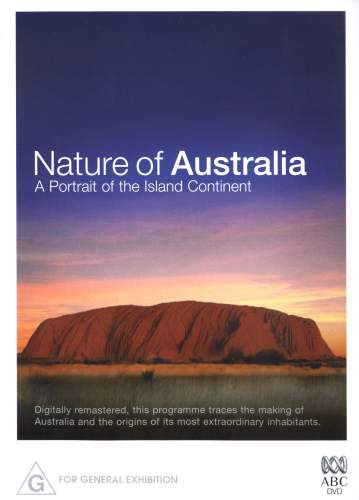Nature of Australia (1991) |
|
Nature of Australia (1991) |
|


|
| BUY IT |
| General | Extras | ||
| Category | Documentary |
Main Menu Audio Scene Selection Audio Gallery-Photo |
|
| Rating |

|
||
| Year Of Production | 1991 | ||
| Running Time | 274:21 (Case: 250) | ||
| RSDL / Flipper |
RSDL (27:37) Dual Disc Set |
Cast & Crew | |
| Start Up | Ads Then Menu | ||
| Region Coding | 1,2,3,4,5,6 | Directed By | David Parer & Dione Gilmour |
|
Studio
Distributor |
 Roadshow Home Entertainment |
Starring | Narrated by Robyn Williams |
| Case | Amaray-Transparent-S/C-Dual | ||
| RPI | $59.95 | Music | Kevin Hocking |
| Video | Audio | ||
| Pan & Scan/Full Frame | None | English Dolby Digital 2.0 (224Kb/s) | |
| Widescreen Aspect Ratio | 1.78:1 | ||
| 16x9 Enhancement |
 |
||
| Video Format | 576i (PAL) | ||
| Original Aspect Ratio | 1.78:1 | Miscellaneous | |
| Jacket Pictures | No | ||
| Subtitles | English for the Hearing Impaired | Smoking | No |
| Annoying Product Placement | No | ||
| Action In or After Credits | Yes | ||
When people think of reality television these days they immediately think of Big Brother or Australian Idol but there is a different type of reality television, one that actually stimulates the brains cells rather than slowly eroding them. I speak of the humble nature documentary which, unlike the other reality television, seldom loses its appeal. Nature Of Australia represents the ABC's Natural History Unit at its very best - this stunning documentary is a visual journey through our Great Southern Land.
The DVD includes all five programs from the series, each clocking in at around 50 minutes each. The programs are:
This is a somewhat unusual documentary in that it is totally narration based, so there is no presenter, which doesn't really bother me because, let's face it - if you're not David Attenborough you need not apply.
There is certainly some magnificent cinematography to be found during this series - seemingly the Natural History Units' budget at the ABC was a very healthy one indeed, not to mention the assistance from the BBC. There are animals photographed here that I genuinely never knew existed here in Australia like the desert mole. There are also a few 'moments of clarity' like how koalas have only migrated into the trees recently in the evolutionary scale which explains why they're so clumsy at climbing. A great deal of money, time and effort has been put into this production so I'm thankful this documentary hasn't disappeared into the vaults at the ABC.
Finally, I'll finish this synopsis with one of my favourite images and quotes of this series, this one from the Land Of Flood & Fire program. The image - in an attempt to escape the impending danger of the floods we see that a python and water rat have seemingly inadvertently scurried up the same small shrub. The narration - "Odd companions, a python shares its refuge with a water rat. In this common crisis, normal predatory instincts are suspended". Irrespective of the narration that rat is the most worried looking creature I think I've ever seen.
The transfer is presented in 1.78:1 and is 16x9 enhanced. All indications suggest this is the original aspect ratio. From the outset it must be pointed out that this entire series has been shot on film - high grain film at that. Indeed the film grain in the opening shots of the first program clearly indicate the programs' source which, being an ABC production made for television, would most likely be 16mm. By simple way of deduction you can reach this verdict - 8mm doesn't have this much resolution and not even the ABC would spring for 35mm for a documentary, particularly one of this length. Normally, I don't have a problem with film grain - it is what it is and is inherent to film - but there is a time when it is not being used for artistic reasons that it becomes annoying and this is one of those times. The choice of film stock for this series is certainly not what I would call a good choice.
Detail is for the most part is quite high which to me suggests that this might in fact be a fresh film-to-video transfer by the ABC.
Colours are at times gloriously rich, at other times a little dull and faded but overall pleasing given the film stock used.
Now we come to the big disappointment of the transfer - MPEG artefacts. Nature Of Australia represents an extreme example of posterization - indeed the entire transfer suffers from it - there is seldom at shot that doesn't display this artefact. However, for various reasons the posterization is not as objectionable in this transfer as others I've seen. This is mainly due to the presence of the film grain which tends to help blend in the artefact while paradoxically being partly responsible for its creation (more on that in a moment). The second program, Seas Under Capricorn, is by far the worst affected - the combination of the heavy film grain and murky water proves to be a lethal combination for the MPEG encoder. A highlight example occurs at 15:21 during a shot of a great white shark - it's an absolute mess of posterization with the encoder clearly unable to handle the huge number of colour transitions within the image. Having previously seen film grain handled well by MPEG encoders - shining examples include U2's Rattle & Hum and Oliver Stone's U-Turn - I can only conclude that the MPEG encoder used here was just simply not up to the task. However, rather perversely the bit-rate indicates that the compression has indeed been given the necessary breathing room with the opening shots of The Making Of The Bush pushed right up to 9.9Mbs. I'm of the view that even if the transfer had been given a constant 10Mbs bit-rate the posterization problem would still exist due to the poor quality of the MPEG encoder used.
Film artefacts are present throughout all of the programs in the form of negative (white) artefacts and there's a very good reason why. With a lot of the filming taking place out in the desert during the driest and dustiest months of the year it would have been inevitable that the stock would have been exposed to some dust no matter how much care was taken at the time to avoid it. This explains why nearly all of the film artefacts are negative ones. There is also the odd vertical scratch but like the film artefacts these are not particularly bothersome as the grain does tend to draw attention away from them. For some reason the presence of film grain always diminishes my annoyance of film artefacts - I guess they cancel each other out in a strange way. There is also a small amount of telecine wobble present as well as an odd jump and warping in the image for a few frames before nearly every cut. No doubt a by-product of the original film editing, not the transfer, it's not a major issue with only its frequency giving away its presence.
The is a single subtitle track present - English for the Hearing Impaired. A brief sample of it indicated it to be word perfect. Being for the hearing impaired there are occasional descriptions of various sounds and music.
Disc 1 is RSDL-formatted with the layer change occurring during Seas Under Capricorn at 27:37. Disc 2 is single layered.
| Sharpness | |
| Shadow Detail | |
| Colour | |
| Grain/Pixelization | |
| Film-To-Video Artefacts | |
| Film Artefacts | |
| Overall |
The audio is presented in English Dolby Digital 2.0 and while it is far less problematic than the video transfer it is not without its own faults.
The narration is loud and clear and very easy to understand. The narrator, Robyn Williams (note that's a 'y' not an 'i' in Robyn, unlike the back cover), has a very interesting accent that I can't quite nail - it's somewhere between being upper-class English and Australian. Problems are few and far between. On a few occasions, however, I noticed the narration went out-of-phase, albeit briefly, spilling it into the left and right channels - two such instances are at 44:47 and 45:23 during A Separate Creation.
The music is performed by the Melbourne Symphony Orchestra and has been composed specifically for this series. For the most part it is low key and adds quite well to the ambience of the footage on screen.
With the exception of The Making Of The Bush, the surrounds are used quite frequently although not to huge effect throughout much of the series. Music and effects including the sounds of birds and insects are sent to the rear channels from time to time. The Making Of The Bush, however, is a different story. For whatever reason this particular program is essentially mono, and as such all the audio collapses into the centre channel when using a matrix decoder - be it Pro Logic II or Neo: 6. Very odd indeed.
| Dialogue | |
| Audio Sync | |
| Clicks/Pops/Dropouts | |
| Surround Channel Use | |
| Subwoofer | |
| Overall |
This is not the sort of program that requires extras, and as such there's only a photo gallery. Having said that, a commentary from the filmmakers would have been interesting even if only for one of the programs.
Menu
A nice simple menu with audio. There are some forced ads which you must endure before you go to the menu. Thankfully, these can readily be skipped.
Photo Gallery
NOTE: To view non-R4 releases, your equipment needs to be multi-zone compatible and usually also NTSC compatible.
Nature Of Australia is not available overseas.
Nature Of Australia is a visually stunning documentary about Australia and the rich diversity of life which has evolved here over many millions of years. It is highly recommended viewing for Australians and foreigners alike.
The video quality is sadly a big disappointment being let down by an MPEG encoder that was simply not up to the task.
The audio quality is generally good for a straight stereo mix, barring The Making Of The Bush which is strangely monophonic.
This is a DVD all about the program so the absence of extras is not a disappointment.
| Video | |
| Audio | |
| Extras | |
| Plot | |
| Overall |
| Review Equipment | |
| DVD | Pioneer DV-655A, SACD & DVD-A, using S-Video output |
| Display | Loewe CT-1170 (66cm). Calibrated with Ultimate DVD Platinum. This display device is 16x9 capable. |
| Audio Decoder | Pioneer VSX-D1011, THX Select, DTS-ES 6.1 Discrete, DTS 96/24 & DD 5.1 EX. Calibrated with Ultimate DVD Platinum. |
| Amplification | Pioneer VSX-D1011, THX Select, DTS-ES 6.1 Discrete, DTS 96/24 & DD 5.1 EX |
| Speakers | Front & Centre: Monitor Audio Bronze 2, Surrounds: Sony SS-SRX7S, Surround Back: Paramount Pictures Bookshelf Speakers |